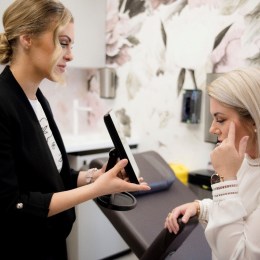This is how you can find out your patients’ motivations for treatment.
With the growing number of patients presenting with Snapchat Dysmorphia, BDD, or those that are plain old-fashioned difficult to deal with, mitigating risk is becoming a much bigger focus for a lot of aesthetic practitioners. Sometimes things go wrong, even if you have done everything in your power to prevent them – but it’s the prevention stage that often leaves room for improvement. There are some strategies you can implement throughout your consultation process that can make a real difference in reducing risk, and according to Dr Katherine Iscoe, there are three key questions you should be asking that could vastly improve outcomes and reduce the chance of dissatisfaction – for both you and your patients.

With a Doctorate in Exercise Physiology and Biotechnology, and Post-graduate Certificate in Counselling, Dr Katherine is a mentor, author and public speaker, whose specialty area of choice is confidence, along with body image, stress management and self-esteem. Dr Katherine has put together three key questions for aesthetic medical practitioners to ask during consultation that can give them the confidence that they have really understood their patients’ motives for their chosen treatment, AND give patients some confidence that their treatment is right for them:
“How long have you been thinking of doing this?”
Confirmation bias, says Dr Katherine, refers to passively ignoring new information even when it counteracts our original decision. Therefore, if you’re making a quick decision, this provides you less time to learn about additional information that might be relevant to your choice. This question will help you assess whether the patient is making an informed and well thought out decision, or if it’s an anxious and likely emotionally-based decision.
You should first discover if their desired treatment is an irrational decision based on an emotional trigger.
“What brought you in today? Why RIGHT now?”
Our more ‘logical’ brain (the pre-frontal cortex) is where we make informed, well thought out decisions – dubbed by Dr Katherine as the ‘Yoda’ part of the brain. In contrast, the limbic centre is home to our emotional intelligence – which could be compared to a hungry, tired toddler (far from rational). When we are emotionally-charged, often ‘Yoda’ is out on vacation leaving only our emotional ‘toddler’ to make our decisions for us – not ideal when making a decision that can have lifelong consequences.
This question will help you understand the motivation behind patient behaviour – is it a logical decision or an emotional decision? Have they had their consult booked for weeks, or have they just booked in after a recent breakup or loss in the family?
“What would your life look like if you didn’t go ahead?”
Tunnel vision, says Dr Katherine, is when we have a very limited perspective, and truly believe the solution we have in mind will magically get rid of any emotional discomfort we’re experiencing. This question determines whether or not a patient is experiencing tunnel vision about their chosen procedure. Do they think it will ‘fix all’ to their problems? Would they still be ok if treatment wasn’t an option?
Patients expressing a strong, anxious desire for the treatment, describing it like an ‘all-or-none’ situation and using words like ‘must’ and ‘have to’, Dr Katherine says should reconsider treatment and should instead seek review by an independent GP or psychologist.




